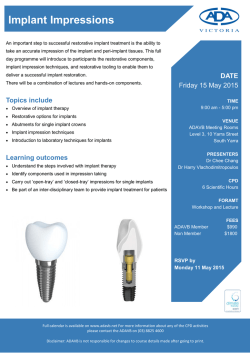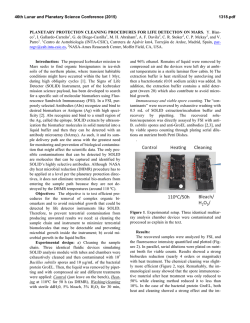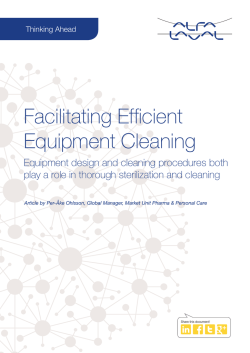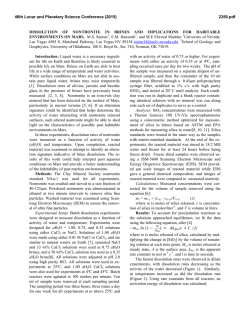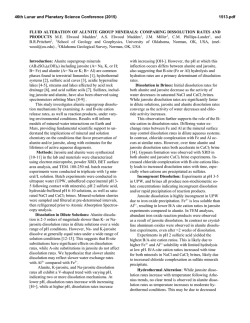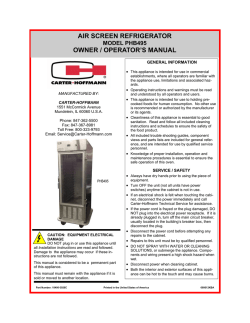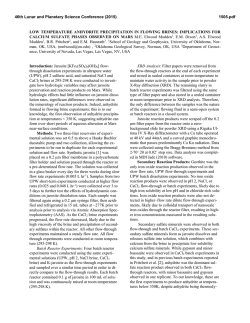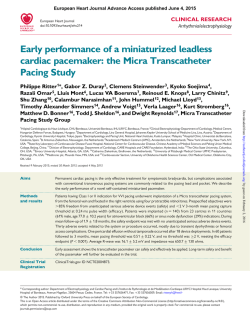
impact of acid-cleaning on the solar wind layer of genesis flight wafers
46th Lunar and Planetary Science Conference (2015) 1266.pdf IMPACT OF ACID-CLEANING ON THE SOLAR WIND LAYER OF GENESIS FLIGHT WAFERS – PARTIAL DISSOLUSION AND RECOVERY OF THE LITHIUM-6 IMPLANT. N. Waeselmann1, M. Humayun1, Y.S. Goreva2, D.S. Burnett3 and A. Jurewicz4, 1National High Magnetic Field Laboratory & Dept. of Earth, Ocean & Atmospheric Science, Florida State University, 1800 E. Paul Dirac Dr., Tallahassee, FL 32310, USA ([email protected]), 2Smithsonian Institution, Washington, DC 20004, USA; 3California Institute of Technology, Pasadena, CA, 91125, USA; 4Center for Meteorite Studies, Arizona State University, Tempe, AZ 85287, USA. Introduction: Determination of the oxygen isotope composition of the Sun was the top priority for the NASA Genesis mission [1]. The successful measurement of oxygen isotopes [2] has triggered a discussion on the role of mass fractionation due to Inefficient Coulomb Drag, ICD [3], that may have displaced the oxygen isotope composition of the solar wind from that of the photosphere. There are other interpretations involving photochemically-induced mass-independent fractionation in the solar wind [4]. These issues can be resolved by determining the Mg isotope composition of the solar wind, which is currently the highest priority objective for the Genesis mission. Attempts to determine Mg isotopes in situ by back-side depth profiling have not achieved sufficient precision to yield a definitive answer [5], so that precise measurement by bulk analysis of SW-derived Mg is required. Previously, we reported Mg isotopes on Si-onsapphire (SoS) wafers [6]. We found a mild, massdependent fractionation due to differential implantation of Mg isotopes into the sapphire but no evidence of ICD fractionation. To avoid the problem of differential implantation, a new set of measurements on Si wafers has been undertaken. Si wafers pose two very significant problems. First, the surfaces have to be thoroughly cleaned to remove Mg from UTTR debris. The aggressive acid cleaning procedures devised to clean Genesis flight wafers cause concerns that some of the SW implant may be removed, as well, biasing the 26Mg to heavier values. Second, unlike with SoS wafers, achieving a quantitative yield of Si is not easy, which could bias the 26Mg to lighter values. To overcome both of these problems, the wafers under investigation were ion-implanted with 6Li at a fluence about two orders of magnitude higher than that of SW Mg. The 6Li implant was designed to overlay the solar wind layer at a depth of 50–200 nm below the exposed surface. Methodology: The 6Li implant was performed by Leonard Kroko Inc. at an energy of 15 keV and a beam current of 0.4 µA for a fluence of 3E14 ions/cm2. Figure 1 shows a SIMS depth profile of the 6Li implant. Samples: A-5 CZ is a 1.16cm2 non-flight CZ Si wafer used as a 6Li implant control. 60491 and 60500 FZ are flight samples of ~0.2 cm2 from a focused study of the effectiveness of aqua regia cleaning [7]. The samples were imaged by ToFSIMS before and after the cleaning procedure [7]. It should be noted that the surface of 60500 was partially covered with conducting paint during the 6Li implant process. 60493 FZ is a ~0.2 cm2 flight sample which was cleaned with boiling sulfuric acid. The ToF-SIMS imaging before and after the cleaning procedure noted that sulfuric acid effectively removed all observed contaminants, but the absence of the 6Li signal after cleaning indicated that substantial Si was removed as well [7]. Method: The implanted surface of the Si wafer was etched (approximately uniformly) in the following way. Hydrofluoric acid was pre-diluted with nitric acid to a HF concentration of 1%. From this premix a 100 µL drop was placed in a clean Savillex™ PFA vial and the Si wafer placed on top of it, solar wind-exposed surface down, in order to dissolve the implanted solar wind with minimal Si-removal from the wafer. After 5 minutes the reaction was stopped by adding 900 µL water, the wafer was removed and the solution split in aliquots for isotope composition (IC) and isotope dilution (ID) measurements. As a spike for ID measurements, a well-characterized high-purity standard Lithium solution was used with a 7Li/6Li ratio of 15.1 ±0.3. The IAEA’s L-SVEC natural Li standard was used to monitor instrumental mass bias. The partial dissolution was set up to dissolve ~300 nm per dissolution step (sufficient to remove the implanted solar wind). Each Si wafer was subjected to two dissolution steps to ensure that there was no 6Li remaining in the Si wafer. The aqua regia cleaning applied to 60491 and 60500 involved three steps, each of which was dried down and redissolved in 1 mL of 2% HNO 3 for ICPMS measurements. The measurements were performed on an Element XRTM at the Plasma Analytical Facility of the National High Magnetic Field Laboratory using Thermo Super Jet 8.2 Ni sampler and Spectron T1001 Ni-X skimmer cones with a sensitivity of 60 Mcps/ppb of 115In. Sample introduction was performed with an ESI ApexQ™ sample introduction system and a 20 µL/min Savil- 46th Lunar and Planetary Science Conference (2015) lex™ PFA nebulizer. The detection limit of 6Li was 0.1 ppt or 0.00006E14 atoms 6Li for 1 cm2 wafer. Discussion: The 6Li fluence in the ion implantation at Kroko has been measured here by isotope dilution as 3.20E14 atoms/cm2 (Table 1). This corresponds well with the nominal fluence provided by Kroko of 3E14 atoms/cm2. The ToF-SIMS study [7] showed that the aqua regia treatment produced surfaces from which most of the original particulate contamination had been removed. Measurements of the aqua regia cleaning steps on 60491 and 60500 showed no detectable 6Li in the case of 60491 (≤ 0.01% of total 6Li based on 3E14 atoms/cc) and approximately 0.1% 6Li in the case of 60500 (Table 1). Integrating the Mg profile that corresponds to the 6Li profile, with the achievable precision of 1-2 ‰ in 26Mg, a shift in δxMg is only resolvable for losses in 6Li greater than 3%. Thus, the aqua regia cleaning procedure is aggressive on particulates originating from the crash, but does not measurably impact the underlying Si wafer. Due to the high boiling point of sulfuric acid (330°C) it is not possible to dry down the acid, and the sulfuric acid cannot be directly introduced into the ICP-MS to measure the 6Li removed during the cleaning step. So, no data is reported for this step in Table 1. ToF-SIMS images concluded that the sulfuric acid cleaning destroyed the solar wind layer in 60493 [7]. Sample 60493 was subjected to two HF-HNO3 dissolution steps. The 6Li implant recovered in the first step corresponds to <1% of the original implant. No further 6 Li was recovered in the subsequent dissolution step. This confirms the result of the ToF-SIMS analysis: boiling sulfuric acid cleaning of Genesis flight Si wafers destroyed the solar wind layer, although similar damage to non-flight controls was not noted. Table 1: 6Li recovery in cleaning and dissolution steps 6 6 Sample Acid Li in acid Li in HFCleaning cleaning step HNO3 dissolu[E14 atoms\cc] tion step [E14 atoms\cc] Kroko ~3 A-5 3.20±0.28 60491 ARa 0.0097 3.2 b 60493 SA 0.04 60500 ARa 0.0026 2.7 a aqua regia b sulfuric acid HF-HNO3 dissolution on sample 60491 and 60500 showed a full recovery of the 6Li implant in the first 1266.pdf dissolution step (Table 1). A second HF-HNO3 dissolution performed did not yield any detectable 6Li. Figure 1: The cumulative 6Li with depth from the surface is calculated from a SIMS depth profile and plotted as a black dashed line. The SIMS 6Li profile is shown as a solid black line. The gray area represent a 10% error on the cumulative 6Li. Sample and control measurements are represented by colored symbols. Note that the red square represents both the control A5 and 60491. The recovered 6Li from 60491 and 60500 matches the expected fluence of 3E14 (± 10%) atoms/cc established by A-5 CZ within error. The fluence of the control A-5 and 60491 give exactly the same value. Sample 60500 is ~10% lower than the expected fluence; this is the sample where a pre-implant photograph of the sample plate shows conducting paint splashed on the surface prior to the implant process. Conclusion: The aqua regia cleaning technique was found to not remove any significant 6Li (<0.1%) from the implanted wafers. The HF-HNO3 dissolution step obtained quantitative yields for 6Li on each wafer. Each wafer was processed twice with HF-HNO3 dissolution. The first dissolution step removed all of the 6Li as expected, and no 6Li was detected in the second dissolution step. We infer that we removed >300 nm of Si during each dissolution. These results demonstrate that – with a single 6Li implant at 15 keV – Genesis Si collectors can be suitably used for Mg isotope analyses of the solar wind by ICP-MS analysis. References: [1] Burnett D. S. et al. (2003) Space Science Rev 105, 509-534. [2] McKeegan K.D. et al. (2011) Science 332, 1528-1532. [3] Bochsler P (2000) Rev. Geophys. 38, 247-266. [4] Ozima M. et al. (2012) Met. Planet. Sci. 47, 12, 2049-2055. [5] Heber V. et al. (2014) LPS 45, Abstract #1203. [6] Humayun M. (2011) LPS 42, Abstract #1211 [7] Goreva Y. et al. (2014) LPS 45, Abstract #2568.
© Copyright 2025
